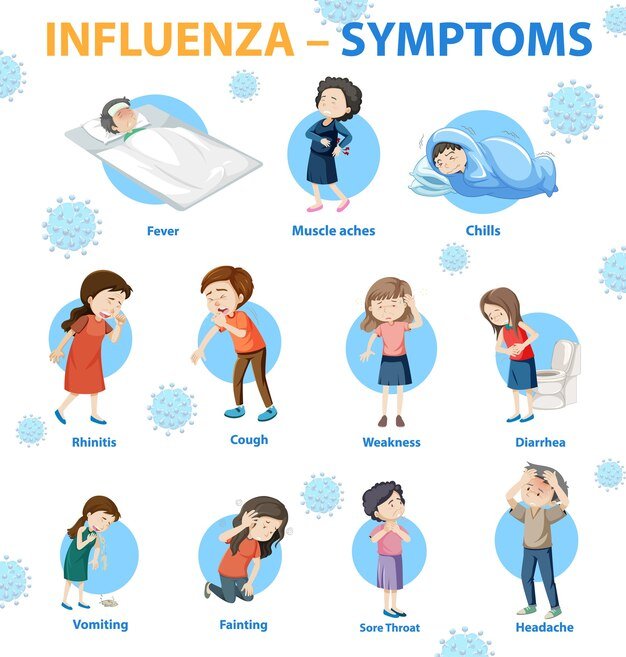Ever wondered how Parainfluenza vs Influenza are different? To put it briefly, parainfluenza primarily leads to upper respiratory symptoms like cough and croup, while influenza causes intense fever, body aches, and widespread respiratory distress.
Respiratory infections are a common health concern, often causing confusion due to overlapping symptoms. Parainfluenza and influenza are prime examples, both affecting the respiratory system but caused by different types of viruses. Understanding the distinctions between these infections is essential for accurate diagnosis and appropriate treatment.
Understanding Viral Infections

Viral infections are a significant category of illnesses caused by various types of viruses that invade and replicate within host cells. These microscopic agents can affect a wide range of organisms, from humans and animals to plants and bacteria. Viral infections can lead to a diverse array of symptoms, ranging from mild discomfort to severe illness. The complexity of viral infections lies in their ability to hijack the host’s cellular machinery to reproduce, potentially damaging tissues and triggering immune responses. Developing a comprehensive understanding of viral infections is crucial for effective prevention, accurate diagnosis, and the development of targeted treatments and vaccines.
Understanding Parainfluenza
What is Parainfluenza?
Parainfluenza viruses belong to the Paramyxoviridae family and are a common cause of respiratory infections, especially in children. These viruses typically affect the upper respiratory tract, causing symptoms such as coughing, sneezing, and nasal congestion. While parainfluenza infections are generally less severe than influenza, they can still lead to discomfort and complications, particularly in vulnerable populations.
Types of Parainfluenza Viruses
There are four types of parainfluenza viruses (PIV 1-4), with each type causing slightly different symptoms and levels of severity. PIV-1 and PIV-2 are often associated with croup, a condition marked by a barking cough and difficulty breathing. PIV-3 is known for causing bronchiolitis and pneumonia, especially in infants and young children. PIV-4 primarily leads to mild respiratory symptoms.
Exploring Influenza
What is Influenza?
Influenza, commonly known as the flu, is a viral infection caused by influenza viruses. These viruses are categorized into types A, B, and C, with influenza A viruses having various subtypes. The flu is known for its sudden onset of high fever, body aches, and fatigue. Unlike parainfluenza, influenza infections can result in more severe symptoms and complications, especially among high-risk individuals.
Types of Influenza Viruses
Influenza type A viruses are notable for their ability to undergo significant genetic changes through a process known as antigenic shift. This characteristic can lead to the emergence of new strains, which is why seasonal flu vaccines need to be updated regularly. In contrast, influenza type B viruses are less likely to cause pandemics and are usually associated with milder symptoms.
Parainfluenza vs Influenza: Transmission

Transmission of Parainfluenza
Parainfluenza viruses spread through respiratory droplets, commonly when an infected person coughs, sneezes, talks, or even breathes. These tiny droplets containing the virus can be inhaled by others, leading to infection. Moreover, the viruses can also survive on surfaces for a limited period, making direct contact with contaminated surfaces another mode of transmission.
Transmission of Influenza
Similar to parainfluenza, influenza viruses spread through respiratory droplets expelled when an infected person coughs, sneezes, talks, or breathes. The contagious nature of influenza contributes to its rapid spread, especially in crowded places such as schools, workplaces, and public transportation.
Parainfluenza vs Influenza: Comparing Symptoms

Parainfluenza Symptoms
Parainfluenza infections often lead to symptoms such as a runny or stuffy nose, cough, sore throat, and mild fever. More severe cases can result in croup, causing a distinct barking cough, hoarseness, and difficulty breathing. In older children and adults, parainfluenza symptoms may resemble those of a common cold.
- Runny or stuffy nose
- Cough
- Sore throat
- Mild fever
- Hoarseness
- Barking cough (especially with croup)
- Difficulty breathing (in severe croup cases)
- Sneezing
- Nasal congestion
Influenza Symptoms
Influenza symptoms are more intense and abrupt, somewhat similar to strep throat. Gastrointestinal symptoms like nausea and vomiting can also occur, particularly in children. Unlike parainfluenza, the flu can lead to complications like pneumonia, especially in vulnerable populations such as the elderly, young children, pregnant women, and individuals with underlying health conditions.
- High fever
- Chills
- Muscle aches
- Fatigue
- Sudden onset of symptoms
- Headache
- Dry cough
- Sore throat
- Nasal congestion
- Shortness of breath
- Gastrointestinal symptoms (such as nausea and vomiting in children)
- Respiratory symptoms (e.g., coughing, sneezing)
- Complications like pneumonia (especially in high-risk individuals)
Parainfluenza vs Influenza: Diagnosis and Medical Evaluation
Diagnosing both parainfluenza and influenza involves evaluating symptoms, medical history, and possibly conducting diagnostic tests. Rapid antigen tests, reverse transcription-polymerase chain reaction (RT-PCR) tests, and viral cultures are commonly used for diagnosing both infections. Rapid antigen tests can provide quick results for influenza, aiding in prompt treatment decisions. However, false-negative results can occur, necessitating further testing if symptoms persist.
Parainfluenza vs Influenza: Treatment Approaches

Managing Parainfluenza Symptoms
Parainfluenza treatment is generally supportive and focuses on alleviating symptoms. Rest, hydration, and over-the-counter medications like acetaminophen or ibuprofen can help manage discomfort. In severe cases of croup, medical interventions such as nebulized epinephrine or corticosteroids may be necessary to ensure proper breathing and reduce airway inflammation.
Treating Influenza: Antiviral Medications
Treatment for influenza involves rest, hydration, and antiviral medications if administered within the first 48 hours of symptom onset. Antiviral drugs such as oseltamivir (Tamiflu), zanamivir (Relenza), and peramivir (Rapivab) can help reduce the duration and severity of symptoms. These medications work by inhibiting the virus’s ability to replicate and spread within the body. However, they are most effective when initiated early in the course of the illness.
Parainfluenza vs Influenza: Preventive Measures
Preventing Parainfluenza Transmission
Practicing good hygiene plays a crucial role in preventing the spread of parainfluenza. Regularly washing hands with soap and water for at least 20 seconds, using hand sanitizers with at least 60% alcohol, and avoiding close contact with infected individuals are essential preventive measures. Additionally, covering the mouth and nose with a tissue or the elbow when coughing or sneezing can help contain respiratory droplets.
Preventing Influenza: The Importance of Vaccination
Vaccination is the most effective strategy for preventing influenza. Annual flu vaccines are designed to protect against the most prevalent strains of influenza viruses expected to circulate in a given flu season. The vaccines stimulate the immune system to produce antibodies that target specific viral proteins, reducing the risk of infection and its complications. It’s recommended that everyone six months of age and older receive the flu vaccine annually, especially those at higher risk of severe flu-related complications.
Parainfluenza vs Influenza: Challenges and Research Avenues
Efforts to combat influenza are met with challenges such as the ever-changing nature of the virus and the need for annual vaccine updates to match circulating strains. Developing a universal flu vaccine that provides lasting protection against various strains is a major research avenue. Additionally, understanding the mechanisms behind severe flu cases and improving antiviral therapies are vital goals. Global collaboration, advanced surveillance systems, and innovative technologies are driving research to address these challenges and enhance our ability to mitigate the impact of influenza on a global scale.
Parainfluenza vs Influenza: Key Differences at a Glance
| Aspect | Parainfluenza | Influenza |
| Virus Family | Paramyxoviridae | Orthomyxoviridae |
| Symptoms | Cough, runny nose, croup | High fever, muscle aches, fatigue |
| Complications | Croup (severe cases) | Pneumonia, respiratory failure |
| Transmission | Respiratory droplets | Respiratory droplets |
| Target Population | Often affects children | All age groups |
| Vaccination | Limited vaccines available | Annual flu vaccine |
| Genetic Changes | Less frequent mutations | Frequent antigenic changes |
| Treatment | Supportive care | Antiviral medications |
| Severity | Generally milder | Can range from mild to severe |
| Complications | Rare complications | More common complications |
| Prevalence | Common in pediatric cases | Widespread |
Parainfluenza vs Influenza: Conclusion
In summary, while parainfluenza and influenza share some respiratory symptoms, they differ significantly in terms of virus family, clinical presentation, severity, and available preventive measures. Being well-informed about these differences empowers individuals and healthcare providers to make accurate diagnoses, provide appropriate treatment, and implement effective preventive strategies.
[youtube https://www.youtube.com/watch?v=yGtKlYPuFfU&w=560&h=315]FAQs
What is the difference between influenza and parainfluenza?
Influenza and parainfluenza are both viral respiratory infections, but they are caused by different types of viruses. Influenza is caused by influenza viruses and is known for its sudden onset of high fever, body aches, and respiratory symptoms. Parainfluenza, on the other hand, is caused by parainfluenza viruses and tends to result in symptoms like cough, runny nose, and hoarseness, often leading to croup in children. The viruses are distinct in terms of family, symptoms, severity, and potential complications.
Is parainfluenza just the flu?
No, parainfluenza is not the same as the flu. While both are respiratory infections, they are caused by different viruses and exhibit different symptoms. Parainfluenza typically leads to symptoms like cough, runny nose, and croup, while influenza is characterized by high fever, body aches, and respiratory symptoms.
Is parainfluenza the same as the common cold?
Parainfluenza is not the same as the common cold, although some symptoms may overlap. The common cold is primarily caused by rhinoviruses and may include symptoms like runny nose, sneezing, and mild cough. Parainfluenza symptoms are more specific, including cough, hoarseness, and barking cough in croup cases.
Is RSV A parainfluenza?
No, Respiratory Syncytial Virus (RSV) is not a parainfluenza virus. RSV is another type of virus that can cause respiratory infections, particularly in young children and older adults. It leads to symptoms like cough, runny nose, and difficulty breathing.
Does Tamiflu work for parainfluenza?
Tamiflu (oseltamivir) is an antiviral medication commonly used to treat influenza. It may not be effective against parainfluenza, as the viruses causing these two infections are different. Consult a healthcare professional for appropriate treatment recommendations for parainfluenza.
Is parainfluenza highly contagious?
Parainfluenza is moderately contagious and spreads through respiratory droplets. It can be easily transmitted from person to person through coughing, sneezing, talking, or direct contact with contaminated surfaces.
Is parainfluenza worse than the flu?
The severity of parainfluenza and influenza can vary widely among individuals. In general, influenza is associated with more intense symptoms, high fever, and a greater potential for complications, especially in vulnerable populations. Parainfluenza symptoms are often milder, but severe cases can lead to croup and breathing difficulties, particularly in children.
What kills parainfluenza?
Parainfluenza infections are typically managed through supportive care to alleviate symptoms. There is no specific antiviral medication approved for treating parainfluenza, and the body’s immune response plays a key role in fighting off the infection.
How serious is parainfluenza?
Parainfluenza infections are usually mild and self-limiting, with most cases resolving on their own without severe complications. However, in young children or individuals with compromised immune systems, parainfluenza can lead to more severe symptoms, especially if croup develops.
How long is a person contagious with parainfluenza?
A person with parainfluenza can be contagious for several days, typically from a day before symptoms start until around 5-7 days after the onset of symptoms. The contagious period may vary depending on the individual and the severity of the infection.
How long does the parainfluenza virus last?
The duration of parainfluenza infections can vary, but symptoms typically improve within a week. In some cases, symptoms like a mild cough may persist for a couple of weeks.
How long will you test positive for parainfluenza?
Diagnostic tests like PCR can detect the presence of parainfluenza viruses in respiratory samples. However, the duration of viral shedding (testing positive) can vary and may extend beyond the time when symptoms are present.
Do adults get parainfluenza?
Yes, adults can contract parainfluenza infections, although they are more common in children. In adults, parainfluenza viruses can cause symptoms similar to the common cold or a mild respiratory infection.
How do you treat parainfluenza at home?
Home treatment for parainfluenza involves rest, staying hydrated, using over-the-counter medications for symptom relief (under a doctor’s guidance), and maintaining good hygiene to prevent spreading the virus to others.
How do you test for parainfluenza?
Parainfluenza infections are typically diagnosed through respiratory samples, such as throat swabs or nasal swabs. These samples are then tested using techniques like PCR to detect the presence of the virus’s genetic material. A healthcare professional can guide you on appropriate testing procedures.
References
- MedlinePlus: https://medlineplus.gov/
- World Health Organization (WHO): https://www.who.int/
- Centers for Disease Control and Prevention (CDC): https://www.cdc.gov/


